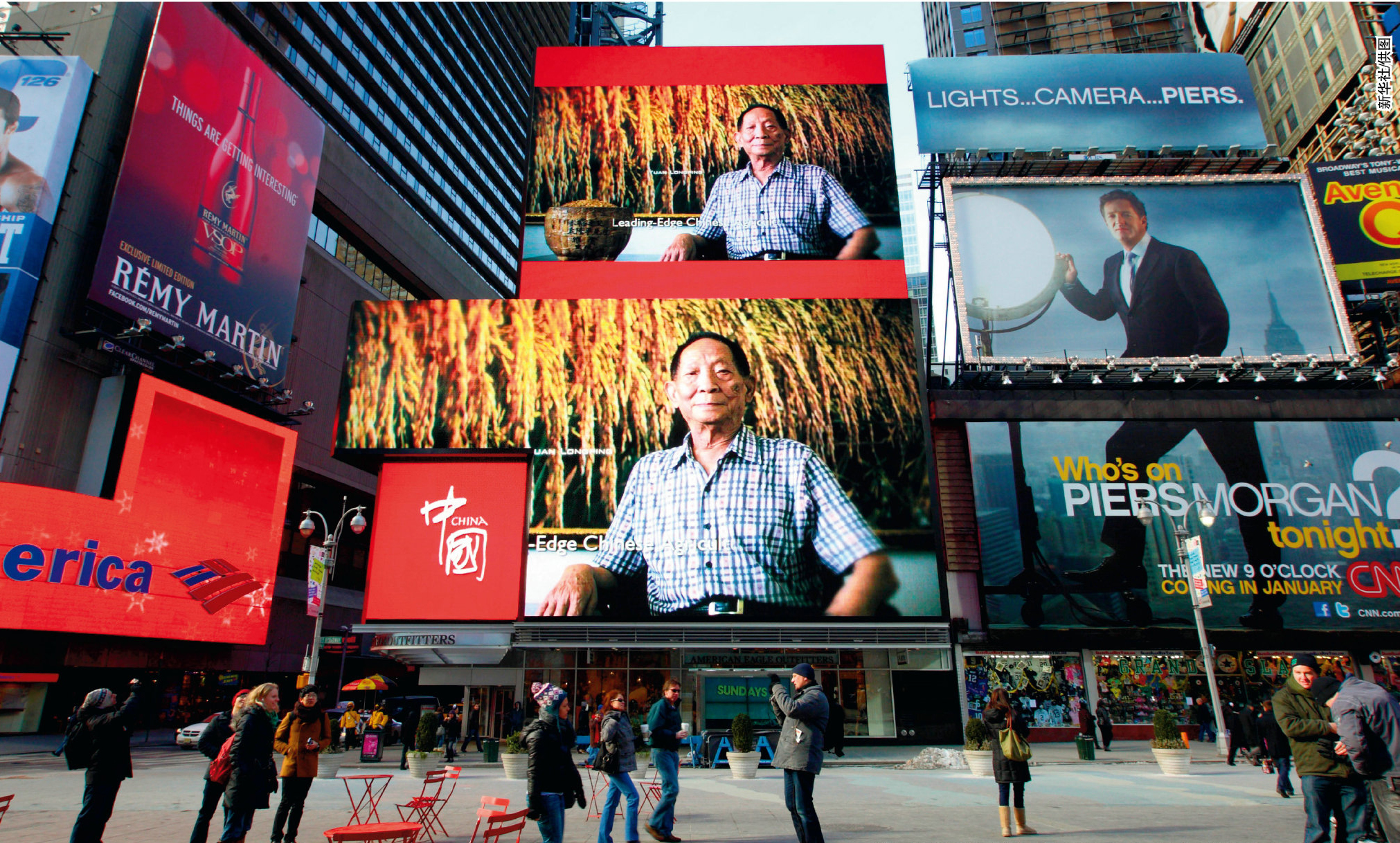Intercultural awareness key to national branding

“Experience China,” a short film promoting China’s cultural heritage and modern achievements, premiered at Times Square, New York City, on Jan. 17, 2011. Shown on the screen is Yuan Longping, a prominent Chinese agricultural scientist. The hybrid rice species he cultivated have helped millions avoid famines and poverty.
Communicative effect is the core concern of journalism and communication studies. Currently, the second stage of a government-sponsored international publicity project is underway. Several cross-national surveys and studies have shown that the project has already borne fruit.
New order
In the realm of international communication, China has long been contained by an American and British monopoly. Evidently, augmenting China’s international publicity should begin with breaking the monopoly and transcending the exclusive mode of thinking.
Various theories and practices of mass media converge on one point—communication is far more complex than the mere flow of information. As an essential component of human civilizations, mass media has been adequately industrialized and socialized. At certain crucial junctures, it has been the decisive force in shaping cultural transition and progress.
That is why media scholars around the globe have called for establishing a more rational order of international communication. The earliest discussions dated back to the 1970s, attempting to counterbalance the old order imposed by developed countries and their multinational corporations, while establishing a fair, democratic and harmonious system of information and cultural exchanges.
China is not alone in opposing the monopoly of American and British media. Many Western countries in which English is not the native language, such as France and Italy, share the same concerns, and they labor toward the same cause as China. Lying in the heart of such an enterprise is discursive power.
Restructuring channels
Corporations at the top of global media value chain are defined by three traits: colossal scale, tremendous influence and monopolization. Those at the middle are usually the largest media organizations on a national or regional scale. They tend to be highly credible in specialized fields but are limited in leverage and coverage.
Chinese media, characterized by limited information capacity and passiveness, falls into the second category. A more feasible approach to restructuring international communication channels is to cooperate with Western media and establish overseas correspondent offices.
Restructuring communication channels requires state-owned media to formulate plans to set up branches and dispatch correspondents. At the same time, private media agencies and non-traditional media need to play a more prominent role.
Intercultural awareness
Capacity of international communication is a product of strategic speculation. It is about a country employing various means and channels to export its own political system, values and culture to so-called “cultural Others” while asserting its identity both at home and on a global scale.
As its international publicity project moves into the second phase, it is wise for China to start considering how to deepen its influence on “cultural Others.” This can be a point of breakthrough.
The subject—both the starting and the end point—of intercultural communication studies is the “cultural Others.” Such awareness should be the central tenet of China’s international publicity project that guides each and every concrete procedure, be it message encoding or decoding.
First, it is necessary to clarify the difference between international communication and intercultural communication. International communication aims to transcend national and regional borders to reach a general audience via mass media. Its ultimate goal is to maximize clearly defined national interests on a global scale. Intercultural communication is primarily concerned with the transmission of culture on an individual, organizational or national level. Its goals are coexistence, mutual understanding, cooperation and shared prosperity on cultural grounds. It aims to transmit values, ideologies and cultures across cultural lines via official and public diplomacy as well as commercial, tourist, educational and media exchanges. Its targets—the “cultural Others”—refer to people of different geographical and cultural origins.
In the past few years, the concept of discursive power has been frequently used in the discussions of international communication. Such discussions have revolved around increasing the influence of the national voice on the international arena. They are predicated on two assumptions—China is becoming an increasingly important force in shaping the global agenda, and a just and fair international order can be achieved in the media sphere. China’s surging economic might has reshaped the global media landscape. From the vantage point of international communication, the “Belt and Road” initiative is a structurally transformative force and will usher in profound change in the coming decades.
Chinese culture is rooted in pragmatism. That is why large organizations, government and private business alike often narrowly focus on language training yet ignore cultural awareness. It is only logical that the country’s international communication personnel generally fall short of intercultural competence.
In reality, international communication is effective only when it is in accordance with the core principles of intercultural communication theories. In addition to language, the vehicles of intercultural communication also include non-verbal behaviors, value orientations, values, political rhetoric and translation. In Western countries, training in intercultural competence is the primary means of social integration as well as popularization of mainstream values and public awareness. In elevating China’s international publicity, training in intercultural competence can be a starting point of awareness transformation and desirable communicative effects.
In the past five years, new trends have loomed large in the realm of mass communication on a global scale. Innovative information and communication technologies, defined by mobility, immediacy and communicativeness, have shattered geographical boundaries by breeding millions of cross-national media channels. Media conglomerates are gradually ceding ground to the combined force of the “Internet Plus” mindset and mobile terminals. In this light, role reversal is an increasing possibility in the near future.
Jiang Fei is an associate research fellow from the Institute of Media Research at the Chinese Academy of Social Sciences.

 PRINT
PRINT CLOSE
CLOSE